How To Run 3 Monitors On Windows 7 Laptop
By at present, a dual-monitor setup has become commonplace. Multitasking on a unmarried screen is only way likewise confining. But why stop at two displays? I can speak from experience: Having multiple monitors (and I'chiliad talking three, four, 5, or even six) is just…awesome, and something you totally need in your life.
Correct now, my master PC has a triple-monitor setup: my master 27-inch fundamental monitor, with a 24-inch monitor on either side. I use my extra monitors for a number of things, such as comparison spreadsheets side-past-side, writing articles while too doing enquiry, keeping tabs on my social media feeds, and, of course, watching Netflix.
Using one of your monitors in vertical orientation can make a large difference for scrolling long documents. If you're a gamer, well, surely you can come across how great 3-plus monitors can be for games that support multi-monitor setups. Y'all can even use your TV as an extra computer monitor!
But earlier you jump in, you want to give your multi-monitor plan some forethought. This guide will walk you through all the factors you need to take into account before setting up three or more monitors.
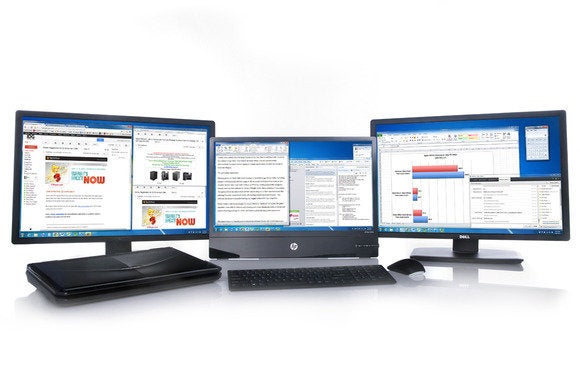
Pace one: Check your graphics menu(s)
Before you run out and buy a bunch of extra monitors, bank check to see whether your reckoner is physically capable of handling all that graphics prowess. Beginning, look at the back of your PC: How many graphics ports (DVI, HDMI, DisplayPort, and VGA) do you see?
If you don't accept a detached graphics bill of fare, you may only run across 2 video ports—nearly motherboards come with integrated graphics that tin merely run dual-monitor setups. If you lot do have a detached graphics card, y'all'll probably see at least three ports, not including the ports on your motherboard.
Tip: While it is possible to set up multiple monitors using ports on both your motherboard and your discrete graphics card, you'll encounter a performance drop and some lag when y'all move windows betwixt monitors. If y'all want to do this, you volition likewise demand to enter your PC'due south BIOS and go to Configuration > Video > Integrated graphics device and fix it to "Always enable."
Just because y'all see three or more ports on your discrete graphics menu, however, doesn't necessarily hateful y'all can use all of them at the same time. For example, many older Nvidia cards are unable to run more than than two monitors on a single menu, fifty-fifty if they have more than two ports. The best manner to find out whether your graphics card supports multiple monitors is to find the name of your carte (Control Console > Device Manager > Display Adapters) and Google it with the monitor setup you're looking to run (eastward.g. "Nvidia GTX 1660 four monitors").
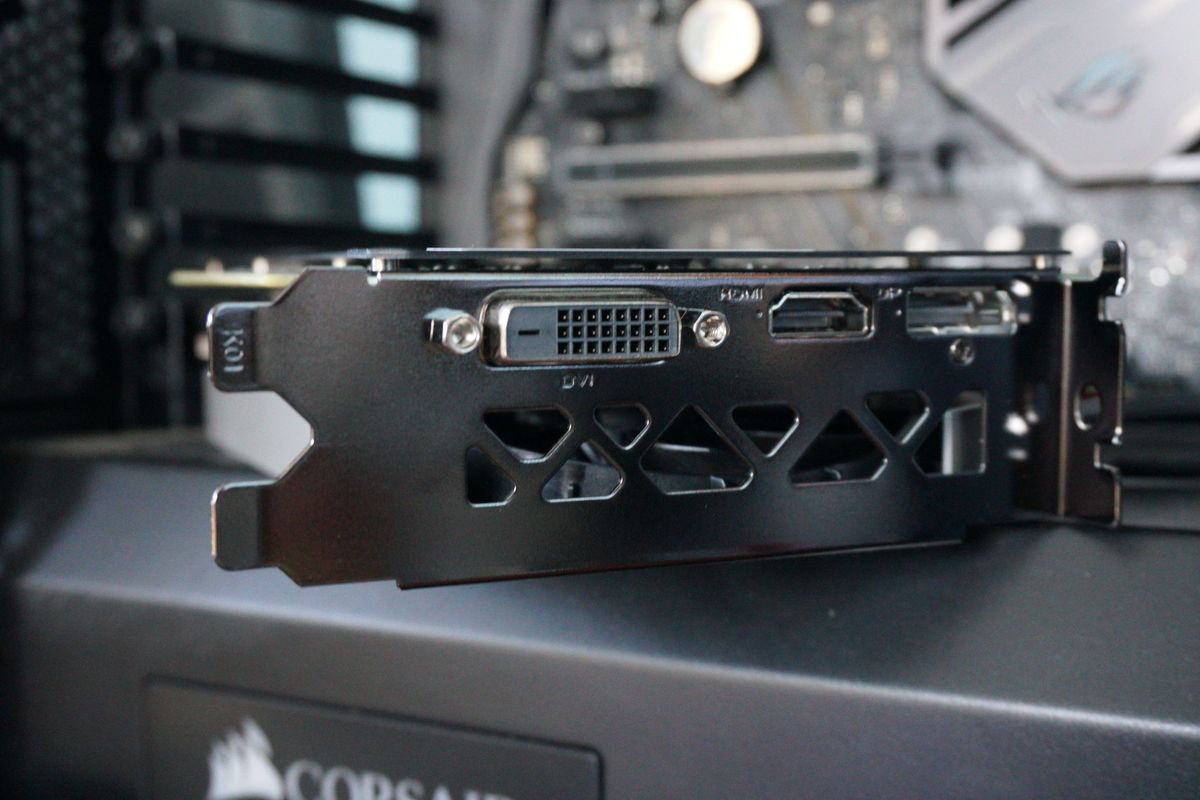
Well-nigh modern graphics cards can ability several displays simultaneously.
If your graphics menu supports—and has enough ports for—the number of monitors you desire to ready, excellent. If non, yous may need to purchase an additional graphics card to get the multi-monitor support you're looking for.
Before you purchase an actress graphics card, you'll need to brand certain you take enough space in your tower (and open PCIe slots), as well as a power supply unit that tin handle the extra strain.
If you lot buy a graphics card solely for the purpose of having multiple monitors, it's best to go a cheaper modern pick, equally electric current GPUs tin power several displays without issue. Check out the best budget graphics menu section of our GPU guide for your all-time options.
Alternatively, monitors with DisplayPort multi-streaming support tin be daisy-chained together from a unmarried DisplayPort connectedness on your graphics card, using boosted DisplayPort cables to connect the additional monitors to one another. The diverse displays don't fifty-fifty need to exist the same size or resolution. ViewSonic'south VP2468 is one such instance. At around $330 on Amazon, this 24-inch monitor is on the pricier side, but in addition to DisplayPort-out, it also offers a premium IPS screen, and a super-sparse bezel, which is ideal for multi-monitor setups.

Step two: Select your monitors
Once yous figure out your graphics carte du jour situation, it'due south time for the fun part: obtaining extra monitors. In general, monitors tin can be had for fairly cheap these days. Bold you tin can't finagle a hand-me-down, a 24-inch monitor with an IPS screen will run yous around $150, such as the Acer R240HY. You can get a 24-inch TN screen, which will likely merchandise potent off-axis viewing for a lower response fourth dimension—something gamers might adopt—for roughly the same money, such equally the Asus VS248H-P ($160 on Amazon). You can also find smaller IPS monitors at around 21.5 inches, such with this HP Pavilion IPS display, for.
Meanwhile, information technology y'all're looking for fifty-fifty more than screen existent estate, you can find a decent 27-inch IPS screen for just a little over $200, such as the $210 ViewSonic VA2759-SMH.
Of course, the perfect monitor for you depends on multiple factors, including the monitors yous already have, the size of your desk-bound, and what you lot're planning on using your extra monitor for. (Of course, resolution is yet another variable, and yous can run across our article about 1080p vs. 4K monitors to assist you lot make a decision in that area as well.)
In my instance, I already had two 24-inch monitors, and I wanted a larger monitor as the centerpiece of my setup, so I picked up a 27-inch monitor and placed information technology between my two 24-inch displays. I'm not using my multi-monitor setup to play multi-monitor games, so the difference in sizes (and the deviation in heights—my 27-inch monitor's stand holds that monitor about one inch college than my 24-inchers) isn't an issue for me. However, if yous're planning on doing a lot of gaming or watching videos that span multiple monitors, this meridian departure volition brand for a not-and then-seamless experience.
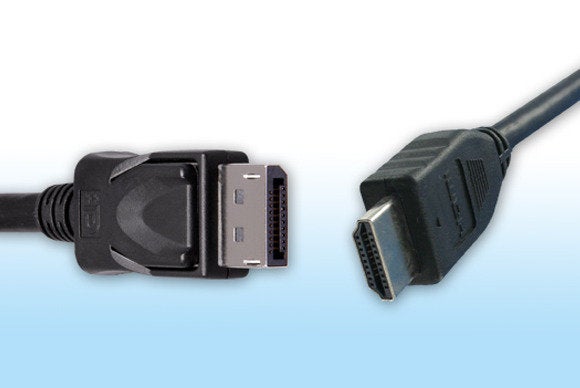
A DisplayPort connector (left) and an HDMI cablevision (right).
Before you purchase your monitors, yous'll likewise want to brand certain they have input ports that correspond with your PC'south output ports. While you could employ conversion cables, such every bit DVI-to-HDMI or DisplayPort-to-DVI, they can be a hassle. If y'all have a VGA port on your PC or your monitor, I suggest staying away from it: VGA is an analog connector, which means your picture will be noticeably less sharp and colors will be less vivid.
Footstep 3: Set up upward your PC
Set up your monitors, plug them in, and turn on your PC. Voila! A perfectly formed multi-monitor setup! Well, not so fast. Setup is easy, just there are still a couple more steps.
The beginning affair y'all'll want to do is configure Windows to play nicely with your multiple monitors. If yous're running Windows 7 or Windows viii, right-click on the desktop and click Screen resolution; in Windows 10, click Display settings. This will take you to a screen where yous can configure the options you have for multiple monitors in Windows.

Here, you tin confirm that all your monitors are detected. Click Identify, which will cause a big number to appear on each of your displays, so you tin determine which screen is which. Select the monitor you'd like to serve as your primary display (which will also determine where your taskbar and Start push appears). A drop-downward menu lets you choose whether to duplicate your desktop or extend your desktop across all the screens. In almost multi-monitor setups, you'll want to extend your desktop across all 3 (or 4, or whatever) of your displays.
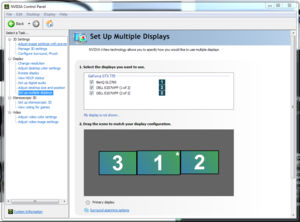
Alternately, y'all can set up your multi-monitor configuration in your GPU's control panel. Right-click your desktop and cull either the Nvidia or AMD control panel (depending on your graphics carte du jour), and notice the Display section, which will offer similar options as Windows.
Gaming
It'south one thing to utilise multiple monitors to do piece of work and scout Netflix. Information technology'due south some other thing entirely to use multiple monitors to play video games. If y'all want to employ your snazzy new multi-monitor setup to do some iii- or iv-panel gaming, at that place are a few actress things you lot'll have to accept into consideration.
Gaming on several displays at once requires far more graphical firepower than gaming on a single screen alone, considering the GPU has and so many more pixels to push—so if you're not running a sufficiently robust graphics carte du jour or cards, you lot'll nigh certainly see lag and artifacting in your multi-monitor games. In one case once more, bank check out PCWorld's guide for choosing the best graphics card for gaming.
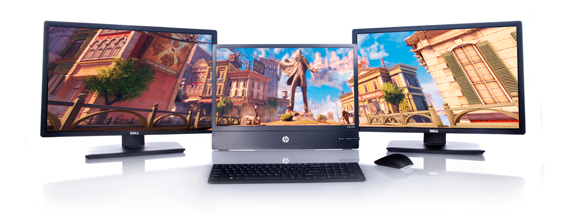
GLORIOUS.
Earlier you can start playing your games beyond multiple panels, you'll need to set up your graphics card and your game. Nvidia users volition need to prepare Nvidia Surroundings, while AMD users will need to create an Eyefinity group for their monitors.
You'll also need to get into your game—not all games are multi-monitor compatible—and configure the video or brandish settings to the correct resolution and then that the game spans across all of your monitors instead of staying squished on just one. Y'all'll as well desire to play around with other settings equally the game allows, including field of view (too low, and there volition exist too much going on around you; also high and everything on your left and right screens will be hugely distorted).
For gaming, it's easier if you have multiple identical displays, because otherwise you'll encounter issues with resolution, distortion (if your displays aren't at the same top), and color calibration, all of which can be difficult to work with if yous're trying to play in a "seamless" surroundings.
If working with multiple displays seems similar more problem than yous want to carp with for gaming, maybe you'd be meliorate off with a single ultrawide monitor. Check out our article on the pros and cons of dual displays versus a unmarried ultrawide.
Note: When y'all purchase something after clicking links in our articles, we may earn a minor commission. Read our affiliate link policy for more details.
Source: https://www.pcworld.com/article/427549/how-to-create-an-insane-multiple-monitor-setup-with-three-four-or-more-displays.html
Posted by: mcgonaglewourease.blogspot.com

0 Response to "How To Run 3 Monitors On Windows 7 Laptop"
Post a Comment